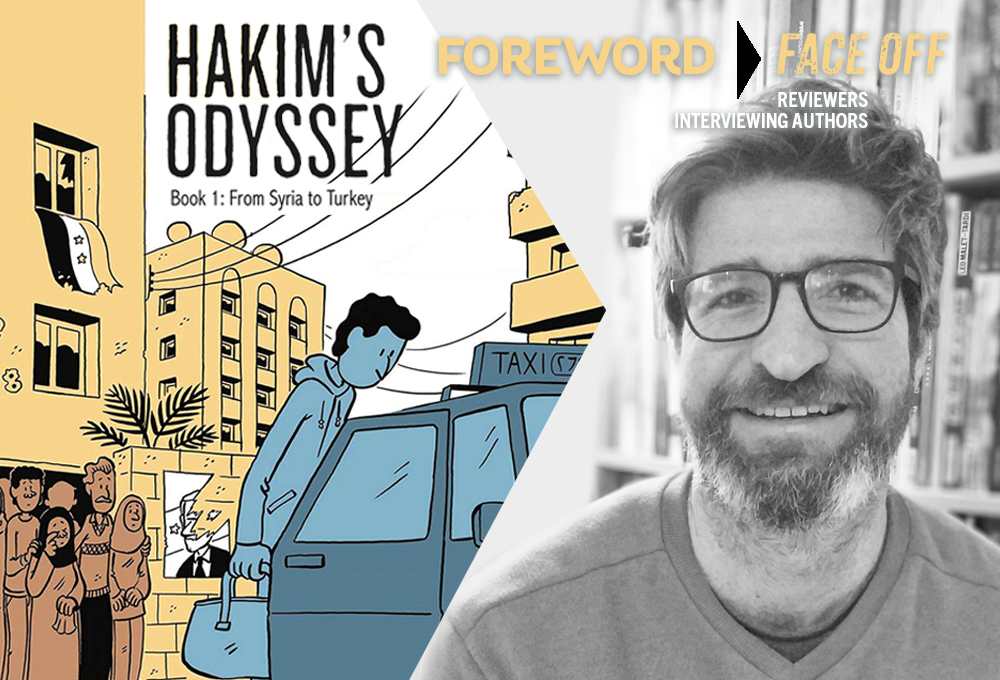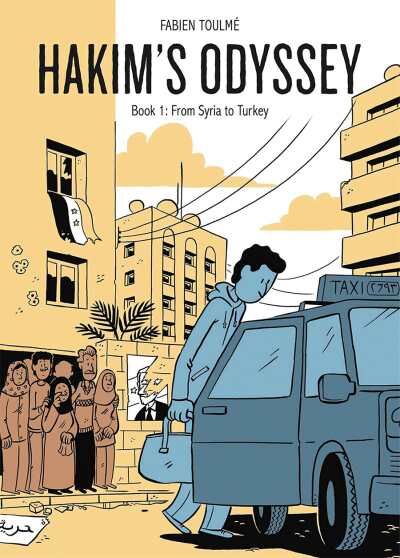Reviewer Peter Dabbene Interviews Fabien Toulmé, Author of Hakim’s Odyssey

One of the consequences of a hot and bothered planet is that human migration will surely be the most intractable, life-threatening issue of the coming decades. Dwindling water supplies, food security, and the accompanying violent competition for resources will put tens of millions of people on the move in Africa and parts of Asia at peril—with scarcely any country prepared to open their borders to take them in.
We’d be wise (and compassionate) to better understand this impending catastrophe with the hope that we can handle it humanely when the shit really hits the fan, which it will as the planet warms further.

This week’s interview between reviewer Peter Dabbene and Fabien Toulmé takes us to the crisis in Syria where more than half the population—some twelve million people—have been displaced in the past ten years, not forgetting the nearly 400,000 killed. Fabien’s graphic novel Hakim’s Odyssey: Book 1 details the true story of a persecuted young man’s escape into Lebanon then Jordan and finally to Turkey—where, happily, he marries.
In his review for Foreword’s November/December issue, Peter calls this first installment of a trilogy—Hakim eventually reaches France—“thrilling, contemplative, tragic, and inspirational.” Those four adjectives were just what we needed to set up this conversation.
First, congratulations on a book that’s both entertaining and enlightening. In the prologue of Hakim’s Odyssey: Book 1: From Syria to Turkey, you describe how the idea for the book came about, and how you came into contact with Hakim through a journalist friend. Once you decided that you wanted to tell a migrant’s story, how did you decide that Hakim’s story would be the one? Were there other migrants with equally compelling stories that you considered, or was it difficult to find someone willing to talk as honestly and extensively as Hakim?
In reality, the choice of Hakim was not a choice, because he was the first person I met who agreed to testify. There was no selection process and I would have refused to make one anyway. It was not about choosing the story that would have been the most dramatic, but rather about telling the story of a human being to bring him closer to our lives.
You had a summary of Hakim’s story from his asylum application when you first met. Were you surprised by any twists and turns of his tale that weren’t included in that document? Did you immediately see this as a large, three volume project, or did that decision come later?
I did indeed have the broad outlines of Hakim’s story in hand, but I never imagined that it had taken him so long between his departure from Syria and his arrival in France. I thought it had been a much more direct course. If at the beginning I had offered my publisher a book that would have been a one-shot, it was over the course of the interviews that this one-shot turned into three volumes.
Your storytelling style captures the rapid changes brought by war, the transition from Hakim’s life as a business owner with a car and an apartment, to a man detained, interrogated, and forced to leave everything behind. The art is a huge contributor to this, especially for readers who have never been to these parts of the world. How did you depict Hakim’s life in Syria and elsewhere so vividly? Were you able to find visual references or photographs to help you, or did you rely on Hakim to review your drawings and offer suggestions?
The transcript of his life in Syria and all the countries he has passed through is the fruit of my personal experiences, the documentation I have gathered, and the observations of Hakim. For example, I visited the Middle East, including Syria, in the early 2000s. Internet help was very valuable, as well as Hakim’s feedback on particular areas. I also had the help of a photographer who had retraced the migrants’ journey and was able to provide me with photographic documentation.
Have your conceptions about the war in Syria changed after completing this project? If so, how?
I think that, for many people, understanding a conflict or a civil war can seem relatively confusing. Being dedicated to it allowed me to better understand the history of the war and the mechanisms that led to this situation.
In the book’s preface, you mention your concerns about getting the story right, considering that Hakim and his wife didn’t speak French, and his story was relayed to you through a translator. You reference the Italian saying “Traduttore, traditore” (to translate is to betray). For readers of English, there’s yet another level of translation, but the book reads very smoothly, courtesy of translator Hannah Chute. Did she work independently, or did you collaborate with her? Were there any details of story or language that were particularly difficult to get across in English?
I must admit that there was no real exchange with the translator of the English version, but I trust her, in the same way I trust the other translators for languages that I do not know like Turkish or Polish, for example. This is the translation game, accepting that there are small changes. And I am in a good position to know it.
The English translation of Hakim’s Odyssey: Book 2: From Turkey to Greece is only scheduled to be released in March 2022, while the third volume of the story was published in French in June 2020. When did you actually finish your work on the Hakim’s Odyssey saga, and is the delay in publishing a translated English version strange for you? Do you feel as if earlier volumes are ancient history as they come to their foreign publication dates?
I finished working on Hakim’s Odyssey in December 2019. This delay between the time of completion and the time of publication is usual, and in reality I am already busy with other books by the time the published work appears in France or abroad. It’s quite interesting to see how the book appears to the public; by then, I’m almost detached from it because I’m focused on something else.
Hakim’s odyssey is a long and harrowing one, and while obviously yours is a safer experience, telling Hakim’s story must have been a grueling experience in its own right. Are you looking forward to moving on from this story? What’s your next project?
It’s true that both in terms of the breadth of the story and its content, creating Hakim’s Odyssey was an intense experience, which is probably what led me to work on a much lighter fiction (a love story) for my next project. That comic strip Suzette ou le Grand Amour has already been published in France in June 2021, and I am now back to a storytelling style closer to Hakim’s Odyssey for a project that is due to appear in the first half of 2022. In it, I will be documenting accounts of people who have lived through experiences of uprising and struggles in different countries of the world (Lebanon, Brazil, Benin). To avoid routine, I like to vary my style in my comics.
Peter Dabbene
